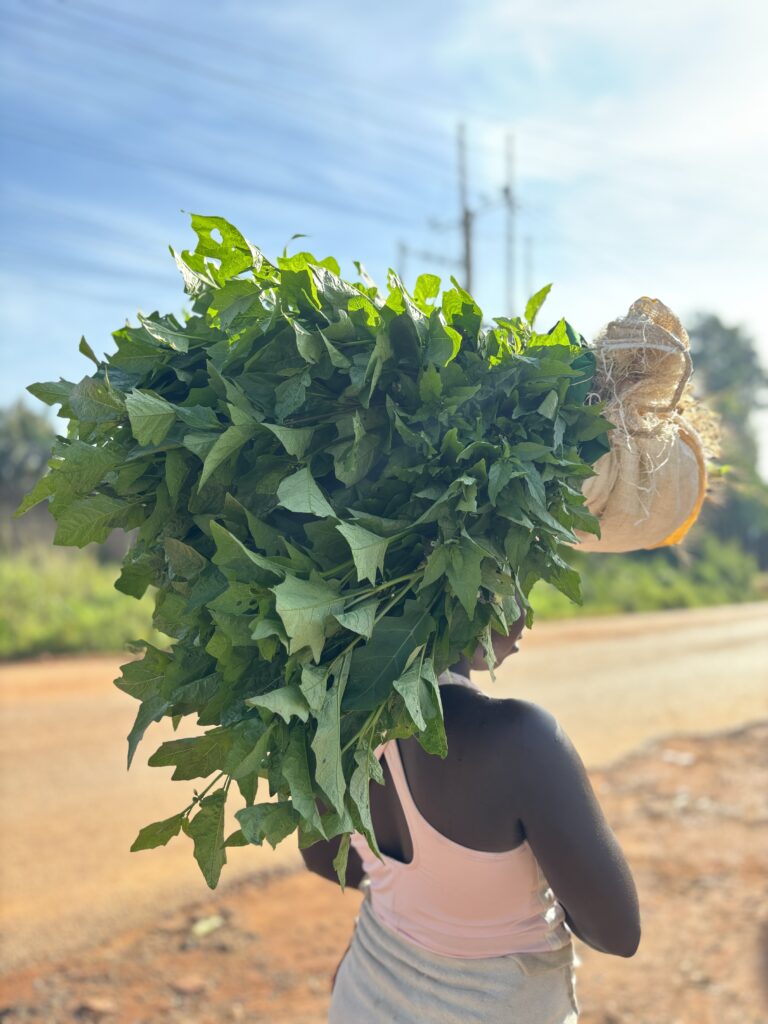The Power of Stories and Photos to Highlight Intersectionality, Gender, and Individual Agency in our work
By Elizabeth Kemigisha, WI-HER Knowledge Management Associate

When we met, I bought two bunches of Nakati from her. I asked, in a lighthearted way, questions to help me learn more about her story. I asked how far she walks and what happens when her stock is all sold, to which she smiled and said, ‘Obulamu bwebutyo,’ which loosely translates to ‘Such is life!’ And I smiled back. We both have a different interpretation of this. She knows this, and I know this too. I asked her permission to take a photo, and she said okay, as long as I did not show her face. She carried the basin to her head and faced the opposite side to allow me the opportunity to take the photo.
Stories and photos can profoundly transform our perspectives, evoke deep emotions, and build connections with the world around us. In our work, where key, but sometimes abstract, concepts like intersectionality, gender, and individual agency play crucial roles in shaping outcomes, the power of storytelling and imagery becomes even more apparent and important.
Intersectionality invites us to identify and listen to the music that is the interconnected nature of social categorizations such as race and ethnicity, gender, age, and more, and these frame our experiences and influence how we perceive and navigate the world. Stories and photos hold space to delve into rich narratives that reflect the complex web of identities that individuals inhabit. For example, in this particular image, the woman is hawking vegetables for sale; but without listening to her story, all we see is a woman selling vegetables. Applying the intersectionality concept invites us to shed light on her multifaceted nature and see her as a mother, daughter, wife, businesswoman, and farmer, and how all these affect her access to more income and a better life.
When we finished taking about three photos, and she approved which one she was comfortable with, I asked to pay for the Nakati I purchased. We agreed on the price, and I shared that I did not have cash, so I asked her to give me her telephone number so I could send her mobile money. She smiled again and read out her number.
In a shy manner, she said, ‘Nanti number yamwami, siyina siimu atte ela nnesente zigenda wuwe,’ which translates to ‘That is my husband’s number, I have no phone, and all the money would be going to him anyway.’ We exchanged our final pleasantries, and she continued with her day. But she stayed on my mind.
I went away thinking about how much power she had to act on the resources they had in the relationship, how fulfilled she may or may not be, but mostly if she had the individual agency to make critical decisions to facilitate her life and that of her family.
During the next couple of weeks, she crossed my mind when I thought about gender, a key component of intersectionality, which shapes power dynamics, opportunities, and challenges in various contexts.
By sharing stories and photos that center on gender, we can amplify often marginalized voices. Through photos and storytelling, we can discuss narratives of resilience, strength, and empowerment, all while highlighting the struggles and triumphs of individuals navigating systems that seek to confine and define them based on gender norms.
With this picture, we could also discuss her potential and celebrate how her business acumen is helping her build her own agency. Even though we do not see her beautiful smile, we immerse ourselves in her story and see it through the lens of intersectionality, gender, and individual agency. We can capture her joy of making a sale, resilience to giving life her all, and her hope that things will improve—and this helps us forge a connection with her because of universal themes of hope and love.
In our work, numbers and statistics take center stage in our discussions. I invite you to employ stories and photos as vital tools for grounding our work in the lived experiences of those we serve, fostering empathy, and forming the foundation for moving towards a more inclusive and equitable world for all.